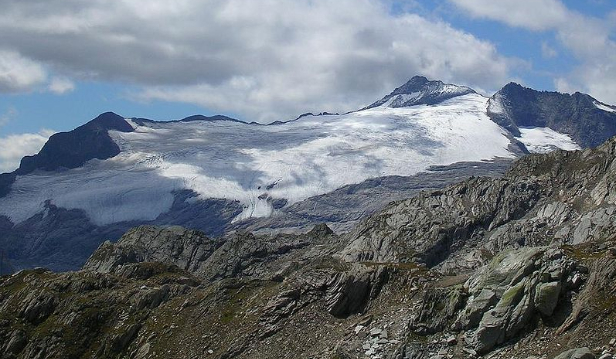 As climate change melts the world’s glaciers, some nations must redefine their national borders. Above, the Basodino Glacier near the Swiss-Italian border.Via Wikimedia Commons
As climate change melts the world’s glaciers, some nations must redefine their national borders. Above, the Basodino Glacier near the Swiss-Italian border.Via Wikimedia Commons
Something really rather strange is happening to Switzerland, where I spent part of last week at an international conference. The mountainous country is shrinking as a result of global warming.
The Italian and Swiss governments have agreed to redraw parts of the border between the two nations — fixed in 1861, when Italy became a unified state. Climate change is increasingly emerging as a cause of changes in national boundaries, something traditionally achieved by warring armies or the stroke of a colonial bureaucrat’s pen.
The 463-mile border mainly runs through the Alps, and was often fixed along the crests of glaciers, where they form watersheds, or along the course of streams gushing out from them. But the glaciers are melting, moving the watersheds northwards into Switzerland. And, as a result, the streams are changing course.
The 5,150 or so glaciers of the Alps lost about a third of their total area between 1850 and the 1970s, and a further half in the few decades since; their volume fell by five percent during the exceptionally hot summer of 2003 alone. And the melting continues to accelerate. In the 13 years from 1991 to 2004, twice as much ice was lost in Europe than in the previous thirty years.
Prof. Roland Psenner, head of Innsbruck University’s Institute of Ecology, predicts that glaciers will all but vanish from the Alps by 2050. And that, he says, is a conservative estimate; if they keep melting at the present rate, most could be gone by 2037. “The future looks rather liquid,” he says.
Boundary changes, with shifts of about 100 meters, are being made near some of the mountain chain’s most iconic peaks, including the evocative Matterhorn and Monte Rosa (whose name comes from a local patois word for glacier). “The border is moving because of the warmer climate,” says Daniel Gutknecht, responsible for the coordination of national boundaries at the Swiss Federal Office of Topography.
In fact, the Swiss-Italian adjustment is only one of three border changes that the Alpine country is making with its neighbors to accommodate climate change. It has already concluded an agreement with Austria that also empowers the two countries to make regular changes as the glaciers melt further, introducing the concept of a movable border. Another deal is expected with France.
Dr. Mark Zeitoun, an expert on transboundary environmental governance at Britain’s University of East Anglia, says it is “fantastic” that Switzerland and Italy are adjusting their borders through talks. “Elsewhere in the world you see a much more nationalistic attitude,” he says.
Indeed, conflicts may well break out elsewhere as glaciers shrink. Worldwide the rate of melting doubled in just two years between 2004 and 2006, and Prof. Wilfrid Haeberli, director of the World Glacier Monitoring Service, speaks of “an accelerating trend with no apparent end in sight.”
Concern particularly focuses on the India’s borders with China and Pakistan, already disputed areas where the melting of glaciers could aggravate tensions. And the water shortages that are expected to strike a billion people as the Himalayan glaciers disappear are likely to prove an even more potent cause of conflict.
It is not just in the mountains where thawing threatens to cause international tension. The melting of the Arctic sea ice, which scientists expect to vanish altogether in summer within a few decades, possibly as early as 2013 — is opening up new shipping routes and access to minerals and fossil fuels. A study by the U.S. Geological Survey, published in May, concluded that the Arctic has 13 percent of the world’s undiscovered oil and 30 percent of its remaining natural gas.
Already, nations surrounding the newly liquid sea are rushing to stake their claims. Two years ago, a Russian submarine planted a titanium flag on the seabed, nearly three miles down at the North Pole, announcing: “We are here to define the outer limit of Russia’s territory.” This spring the country said it would be ready to use military force in pursuit of its Arctic ambitions.
The United States, Canada, Norway and Denmark (through its ownership of Greenland) all have competing claims. A couple of years ago both Canada and Denmark despatched expeditions and warships to defend their claims to the tiny and barren Hans Island in the Kennedy Channel between Greenland and Ellesmere Island.
The next few years are “critical in determining whether the Arctic’s long-term future will be one of international harmony and the rule of law, or a Hobbesian free-for-all with dangerous political conflict,” Dr. Scott G. Borgerson of the Council for Foreign Relations told a Senate committee in May.
Maybe the leaders of the competing countries should settle their differences with a race to the top of the Matterhorn.



